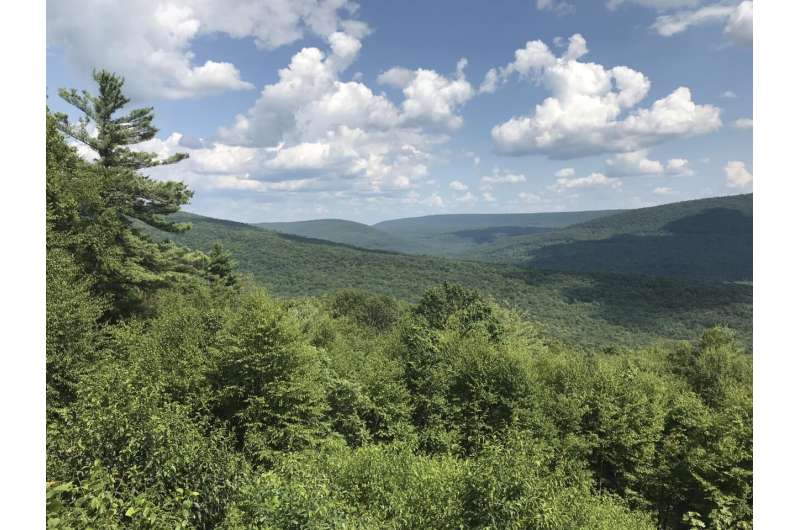This article has been reviewed according to Science X's editorial process and policies. Editors have highlighted the following attributes while ensuring the content's credibility:
fact-checked
trusted source
proofread
Trees struggle to 'breathe' as climate warms, researchers find

Trees are struggling to sequester heat-trapping carbon dioxide (CO2) in warmer, drier climates, meaning that they may no longer serve as a solution for offsetting humanity's carbon footprint as the planet continues to warm, according to a new study led by Penn State researchers.
"We found that trees in warmer, drier climates are essentially coughing instead of breathing," said Max Lloyd, assistant research professor of geosciences at Penn State and lead author on the study recently published in Proceedings of the National Academy of Sciences. "They are sending CO2 right back into the atmosphere far more than trees in cooler, wetter conditions."
Through the process of photosynthesis, trees remove CO2 from the atmosphere to produce new growth. Yet, under stressful conditions, trees release CO2 back to the atmosphere, a process called photorespiration. With an analysis of a global dataset of tree tissue, the research team demonstrated that the rate of photorespiration is up to two times higher in warmer climates, especially when water is limited.
They found the threshold for this response in subtropical climates begins to be crossed when average daytime temperatures exceed roughly 68 degrees Fahrenheit and worsens as temperatures rise further.
The results complicate a widespread belief about the role of plants in helping to draw down—or use—carbon from the atmosphere, providing new insight into how plants could adapt to climate change. Importantly, the researchers noted that as the climate warms, their findings demonstrate that plants could be less able to draw CO2 out of the atmosphere and assimilate the carbon necessary to help the planet cool down.
"We have knocked this essential cycle off balance," Lloyd said. "Plants and climate are inextricably linked. The biggest draw-down of CO2 from our atmosphere is photosynthesizing organisms. It's a big knob on the composition of the atmosphere, so that means small changes have a large impact."
Plants currently absorb an estimated 25% of the CO2 emitted by human activities each year, according to the U.S. Department of Energy, but this percentage is likely to decrease in the future as the climate warms, Lloyd explained, especially if water is scarcer.
"When we think about climate futures, we predict that CO2 will go up, which in theory is good for plants because those are the molecules they breathe in," Lloyd said. "But we've shown there will be a tradeoff that some prevailing models don't account for. The world will be getting warmer, which means plants will be less able to draw down that CO2."
In the study, the researchers discovered that variation in the abundance of certain isotopes of a part of wood called methoxyl groups serves as a tracer of photorespiration in trees. You can think of isotopes as varieties of atoms, Lloyd explained. Just as you might have vanilla and chocolate versions of ice cream, atoms can have different isotopes with their own unique "flavors" due to variations in their mass.
The team studied levels of the methoxyl "flavor" of isotope in wood samples from about thirty specimens of trees from a variety of climates and conditions throughout the world to observe trends in photorespiration. The specimens came from an archive at the University of California, Berkeley, that contains hundreds of wood samples collected in the 1930s and '40s.
"The database was originally used to train foresters how to identify trees from different places around the world, so we repurposed it to essentially reconstruct these forests to see how well they were taking in CO2," Lloyd said.
Until now, photorespiration rates could only be measured in real time using living plants or well-preserved dead specimens that retained structural carbohydrates, which meant that it was nearly impossible to study the rate at which plants draw down carbon at scale or in the past, Lloyd explained.
Now that the team has validated a way to observe photorespiration rate using wood, he said the method could offer researchers a tool for predicting how well trees might "breathe" in the future and how they fared in past climates.
The amount of carbon dioxide in the atmosphere is rapidly rising; it is already greater than at any time in the last 3.6 million years, according to the National Oceanic and Atmospheric Administration. But that period is relatively recent in geologic time, Lloyd explained.
The team will now work to unearth photorespiration rates in the ancient past, up to tens of millions of years ago, using fossilized wood. The methods will allow researchers to explicitly test existing hypotheses regarding the changing influence of plant photorespiration on climate over geologic time.
"I'm a geologist, I work in the past," Lloyd said. "So, if we're interested in these big questions about how this cycle worked when the climate was very different than today, we can't use living plants. We may have to go back millions of years to better understand what our future might look like."
Other authors on the paper are Rebekah A. Stein, Daniel A. Stolper, Daniel E. Ibarra and Todd E. Dawson of the University of California, Berkeley; Richard S. Barclay and Scott L. Wing of the Smithsonian National Museum of Natural History and David W. Stahle of the University of Arkansas.
More information: Max K. Lloyd et al, Isotopic clumping in wood as a proxy for photorespiration in trees, Proceedings of the National Academy of Sciences (2023). DOI: 10.1073/pnas.2306736120
Provided by Pennsylvania State University




















